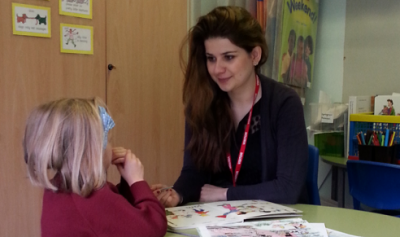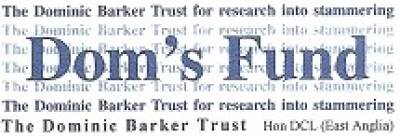This website gives details about our research intended to give guidance to teachers, special educational needs coordinators (SENCos), Speech and Language Therapists (SLTs) working in schools and other professionals in education about a method of identifying children in reception classes who have difficulties producing speech. Reception class children are aged between four and five years. The information provided is based on findings from studies carried out with schools in Ipswich and the London Borough of Merton.
We thank the schools involved (The Priory, Church of England Primary School and Poplar Primary School among others) and the children and their parents for their participation. The research was funded by the Dominic Barker Trust, the Wellcome Trust and University College London. The project is ongoing and the website will be updated as new findings appear.
- Definitions of terms and useful discussion resources
- Speech production difficulties
- The roles of different professionals
- Assessing children's speech production difficulties
- What we do in schools
- What we have found
- What do the schools do with the information we provide?
- Liaison with self-help and SLT groups
- Some issues we are addressing
- Training procedure for teachers
- Can we help?
- How can you help?
- Technical descriptions of background work to the project
- Some key publications
- Fieldwork
- Contact details
Definitions of terms and useful discussion resources
- General information about screening
Visit the following website to obtain general details about screening, familiarize yourself with the technical terms used to report statistics about screening and to understand the limitations of any screening procedure. In our work we are attempting to use our screening tool to identify children in schools who have a speech difficulty.
- Terminological issues associated with Speech and Language
Read about the terms fluency, language (expressive and receptive) and speech here. This site distinguishes language from speech difficulties. Speech, like language, difficulties can be divided into expressive and receptive forms. Our work focuses on identifying expressive speech difficulties.
The term 'disorder' is used on the ASHA website. Disorder is used by SLTs to refer to atypical speech and language. SLTs distinguish speech and language disorder from delay.
'Disorder' is a term that educationalists (and some SLTs) might avoid as it labels a child. 'Difficulty' is a neutral term that incorporates delay and disorder.
Read this article to appreciate the distinction between 'impairment' and 'disability' and why the latter is avoided on our site.
It is appropriate to use 'difficulty' in our work as we do not attempt to distinguish delay from disorder (that is the role of other professionals).
The term 'symptom' is often used in connection with various conditions. An authoritative definition of symptom is: "A physical or mental feature which is regarded as indicating a condition of disease, particularly such a feature that is apparent to the patient". Here, the term 'sign' is used to refer to the overt physical features of speech difficulties ('symptom' is avoided as it may imply speech difficulties are diseases).
'Stammer' is the UK term for what is called 'stutter' in the US. Here is a carefully worded statement that defines stammering/stuttering and the causal factors that have been implicated in the condition.
Look here to see how the term 'disfluency' is used in connection with stuttering. 'Dysfluency' is the spelling that is preferred by the British Stammering Association. Dysfluency is characterized as disruption to the forward flow of speech. Connected speech needs to be assessed to gauge dysfluency. Many available assessment instruments focus on isolated word production. However, Riley's (1994) stuttering severity instrument assesses connected speech.
Figure 1:
Google Ngram Viewer showing frequency of usage of 'stuttering' vs. 'stammering' in the English (British and American combined) corpus (5.2 million books released between 1800-2008).
Speech production difficulties
SLTs already have tests for speech, language and communication that can be used with school-aged children. New tests are also being developed. However, to our knowledge, currently there is no 'initial-screening' tool in the UK specifically for education staff to use, in order to identify different types of speech production difficulties in children, using one simple test. The children are used to speaking to their teacher or with other school workers and this is an activity that all mainstream school children can do. A test involving analysis of a sample of a child's speech formalizes what teachers do informally when exploring the possibility that a child may have a speech production difficulty (the screen has external validity for the teachers).
The roles of different professionals
Teachers and support staff sometimes do not differentiate between speech and language difficulties.
One of the teachers' main roles is to ensure pupils achieve the level of educational attainment they are capable of. From a school perspective speech difficulties are a problem if they impact on the child socially and emotionally or impair a child's attainments (see the NICE guidelines here). Consequently educational attainment as well as any speech production difficulty that has been observed are taken into account when referring a child to an SLT. Speech production difficulties are identified by schools, but at times, this may not be in a systematic way. The present website provides some information and guidance on identifying potential speech production difficulties in schools. Practical considerations lead to constraints on the information that can be collected in schools. For instance, it is not possible to collect information about family history of speech production difficulties (as SLTs would do as a matter of course).
Assessing children's speech production difficulties
A national screening tool for assessing speech and language communication ability has been ruled out by the UK government. Systematic guidance about how to identify speech production difficulties in schools is lacking. It is impractical for SLTs to assess all children although they do advise schools and offer training/awareness sessions for school staff. Basic training of teachers and SENCos could help with the initial identification of speech production difficulties.
SLTs carry out full assessments on children who are referred to them. If teachers or SENCos were trained in identifying children who may have speech production difficulties, then their SLT referrals would be more appropriate. It also helps that they know the children. Although there is a danger of teachers missing some children because their assessments are limited due to the constraints they work under, this would be more likely if no advice was in place for identifying children with speech production difficulty.
What we do in schools
Our procedure is based on Riley's (1994) Stuttering Severity Instrument. A sample of speech is obtained and assessed for any dysfluencies it contains. It is not essential when this instrument is used that the speech is recorded (dispensing with equipment has advantages for schools). In its shortest form, the scores can be obtained from a 200-syllable sample of spontaneous speech. Its brevity and the fact that children who cannot read can be assessed are two further things that commend it for use in schools. The percentage of syllables that are dysfluent is one measure that is obtained. Another is the average duration of the three longest dysfluent syllables. An indication of bodily movements associated with dysfluencies obtained whilst the child is assessed is then combined with the duration and percentage of syllables stuttered to give the final score. The assessment takes a few minutes per child.

What we have found
We assess all reception-class children in the schools we work with using the stuttering severity instrument and report back information on any children who score above a threshold value, indicating that they may have a speech production difficulty, to the schools. We do not offer an indication about the type of speech difficulty. The schools are then asked if they know whether any of their children have speech production difficulties or if they suspect this may be the case. We use the information the schools supply to cross-check and evaluate our results. Children with speech production difficulty are rarely missed by us, and the schools concur with us about 96.7% of the children that we designate fluent. The procedure is successful in picking up speech difficulties other than stuttering (e.g. hearing difficulties that affect speech production, and phonological disorder and delay). This is supported by the statistics just given as the children the schools report about span the complete range of speech production difficulties. The statistics reported here were based on Avin Mirawdeli's PhD work, which is funded by the Dominic Barker Trust (2012-2015).
What do the schools do with the information we provide?
When schools receive an indication that a child may have speech production difficulties, they pass the information on to parents. The schools and parents may seek a referral to an SLT or they may discuss their child's case with the principal researcher (Professor Howell). In cases where a referral is made, it is important that the child is seen as soon as possible by an SLT, so that they can fully assess the child's difficulties and, if necessary, plan an early intervention.
Liaison with self-help and SLT groups
In addition to the Dominic Barker Trust and the Wellcome Trust who have publicized the work they support extensively, we liaise with the British Stammering Association on this research. The BSA's chief executive Norbert Lieckfeldt has tweeted favorably about this work, and an interview of Professor Howell by the BSA's education liaison officer (Cherry Hughes) will appear on their website and a report is planned for their next newsletter. In 2014, the work was presented at the conferences of the European Clinical Specialization in Fluency Disorders in Antwerp and at the Oxford Dysfluency Conference. This year, Professor Howell has talked to groups of SLTs at the Michael Palin Centre, and to groups of SLTs with special interest in fluency, in Birmingham and Leeds.
A Wellcome Trust press release concerning how the Stuttering Severity Instrument can be used to predict whether a child who stutters will persist or recover (Howell & Davis, 2011) can be found here. A press release about the screening work (Howell, 2013) from the Wellcome Trust can be found here.
Some issues we are addressing
A training package is being developed for use by educational staff in schools. We are investigating how we can simplify the Stuttering Severity Instrument procedure that is the basis of the package to make it easier to administer in schools. For example, we are examining whether the duration and physical concomitant measures used in the Stuttering Severity Instrument can be discarded. Also, although the signs of dysfluency used in the Stuttering Severity Instrument identifies children with speech production difficulties other than stuttering, we are examining whether other signs should be included and if some signs currently used can be dropped. When these changes are implemented, the procedure that is the basis of the training package to be used in schools will need to be standardised.
Almost 50% of the children we have examined in both Ipswich and London have English as an additional language (EAL) - see Figure 2 and 3. EAL children who do not have speech production difficulty may show stuttering-like dysfluencies. For example, EAL children with word-finding difficulty may show a lot of repetitions of short words as they stall their speech whilst they are finding the next word they want to say. Fortunately, word repetitions are not considered signs of dysfluency in the Stuttering Severity Instrument. Therefore, an EAL child who displays a lot of these would be identified as having word-finding difficulty, not speech production difficulty unless he or she also had high rates of other of the Stuttering Severity Instrument signs of dysfluency. This feature of the Stuttering Severity Instrument may prevent EAL children from being mistakenly identified as having speech production difficulty, but more checks are needed and improved ways of identifying EAL children with speech production difficulty are required.
Figure 2:
Percentages of EFL/EAL speakers among the examined pupils in visited schools.
Figure 3:
First language of the examined pupils in visited schools. Data collected by A. Mirawdeli in Merton and Ipswich schools for the years 2012-2013 and 2013-2014.
We are developing collaborations with other universities to explore the possibility of automating the speech assessment procedure. This will work from a digital recording of speech that will be processed by an app. An indication whether a child is suspected of having speech production difficulty will be supplied.Teachers and SLTs do not use a speech assessment alone to decide about referral and intervention. They are making different judgments and including different factors when making their respective judgments (educational attainment for schools and additional clinically-relevant factors for SLTs). We are setting up projects to determine how shared (speech assessments) and distributed information (educational attainment and clinical profiling) can work optimally when making referral decisions. This is a judgment that needs to meet the requirements of both groups of professionals.
Confidentiality is an issue schools and SLTs keep in focus. We adhere to data protection legislation, and ensure that individual children cannot be identified from recordings. For example, we obtain speech rather than video recordings to prevent children from being identified and store the recordings using anonymized codes.
Training procedure for teachers
Avin Mirawdeli will propose a prototype training package for teachers to use in order to identify speech production difficulties as part of her PhD work. This will be assessed and refined in future projects.
Can we help?
- Schools
We may be able to come to your school and involve you in this project.
- Parents
We may be able to analyse your child's speech sample. Get in touch to send us a speech sample.
- People who stutter
We want to keep you informed about what we are doing.
How can you help?
- Teachers, SENCos or other workers in a school
We would welcome your feedback and to hear from any schools who would like to become involved. We have designed the procedure so that it meets many practical constraints in schools, but would like to know if we have missed some.
- Speech and language therapists
We would also welcome your views and any ideas about improving the interface between what schools can do practically and how to improve the way this is done so it better meets the needs of the assessment and intervention services you provide.
- Parents
We need more information about children's speech production development. Part of this information is obtained from the recorded interviews with the children whose parents have given permission for the child's participation, but parental expectations about education and communication are also important. If you or your child are prepared to help, please get in contact.
- People who stutter or have other speech production difficulties
Was your difficulty spotted in school and, if so, how did this have an impact on schooling and later life? At some point, we would like to set up focus groups for people whose speech difficulties were missed or spotted.
Technical descriptions of background work to the project
The Howell and Davis (2011) article describes some procedures that looked at how well a set of factors, commonly thought to put children at risk of persistent speech production difficulty, predicted whether the speech difficulty would persist or recover. Howell (2013) extended these procedures to determine whether a similar approach could be employed to identify which children are fluent and which have speech production difficulty. Reed and Wu (2013) is a useful primer on the statistical methods used in these studies.
The two other articles that are listed examine the performance of Riley's stuttering severity instrument, which is the basis of the identification procedure to date. In order for the procedure to be useful in schools, it has to be brief. Todd et al. (2014) looked at the minimum length specified by Riley (1994) and confirmed that a 200-syllable spontaneous speech sample is adequate for use in schools (we are not advocating using such short samples in clinical assessments). Riley (1994) described alternative forms of his assessment that optionally use recording equipment. The schools would prefer not to use recording equipment for convenience and confidentiality (termed the 'live' procedure). All the studies that led up to the proposed identification procedure used audio recordings (termed the 'research' procedure). Jani, Huckvale and Howell (2013) reported how reliable the live procedure is relative to the research procedure and provided a preliminary basis for translation of scores between these two procedures.
Some key publications
Fieldwork
The following report describes how well children with speech difficulty could be identified in school reception classes (based on 730 children).
Mirawdeli, A. (in press). Identifying school-aged children who stutter or who have other difficulties in speech production in school reception classes. Procedia, Social and Behavioral Sciences.
Contact us
Queries or comments about this site should be sent using the form at the end of this page.
If you want to volunteer you can phone on 020 7679 5401 or use the link below:
- Help us improve this page
- Is this information helpful?
please choose here..Yes it isNo it is notIt helped a little
Speech Research Group is partially funded by the Dominic Barker Trust.
 Close
Close



